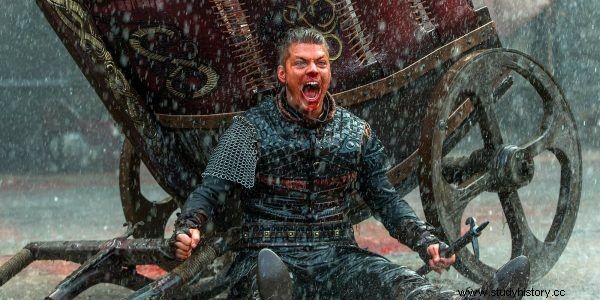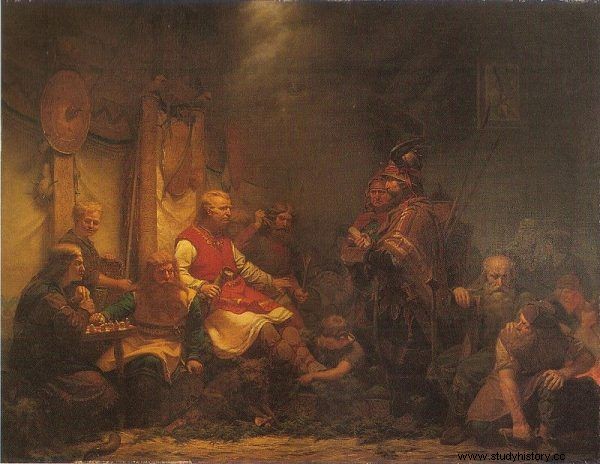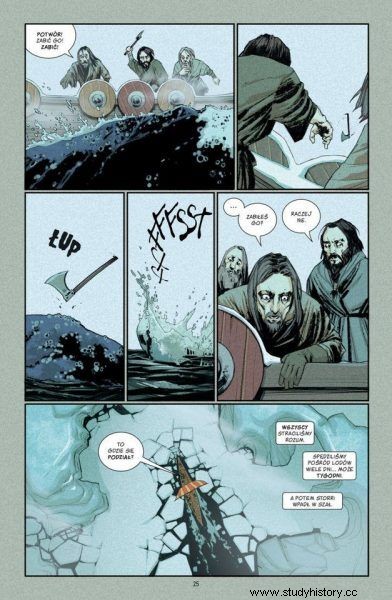Vikings were mentioned in the chronicles and also in legends. Scandinavian warriors - hardened in combat, resistant to severe frosts, experienced in distant, overseas expeditions - aroused fear, but also fascination. What are we really learning about the Viking heritage today?
It is known that they came mainly from the areas of today's Sweden, Norway and Denmark. Baptized by the Germans as Ascomann ("people of ash"), and by the Celts called Lochlannach ("people of water"). You could probably add the term "people of fire", because although the Vikings inhabited areas that were covered with heavy ice in winter, they mastered the art of smelting weapons. And building ships that allowed them to explore distant parts of the continent.
Plunder, rape, conquer…
Ruthless conquerors. Colonizers who forcibly established law and order in the areas they conquered. Calculated, wild, uncouth. The modern, quite common image of the Vikings is true, but - as is often the case - quite incomplete. Because distant expeditions could be robberies, yes, but at the same time merchants and even settlers. Aggressive expansion was primarily the domain of specialized raider groups .

The stereotype of the Vikings as bloodthirsty barbarians has become established in the public consciousness
Conquests - often marked with blood and rape - were associated with a specific way of inheriting power. Only the eldest son inherited the heirloom from his father. The younger ones were, in a way, forced to take over the area thanks to which they could gain wealth, respect and, consequently, social position. The first expeditions began as early as the 8th century, 793 to be exact when they appeared on the coast of England, on the island of Lindisfarne. The burning and looting of the monastery founded by Aidan, an Iro-Scottish monk, was considered the first warrior raid in history. From then on, their reputation for fear began to grow.
… build, trade, develop empires
The Vikings, however, were known not only for their excellent battle skills, but also… entrepreneurship. Marking routes, they also established trade contacts. You should know that apart from the barbaric conquest-oriented groups, among the Scandinavian warriors there were also farmers who efficiently managed their households and clever traders who carried out transactions mainly on the basis of an exchange contract, i.e. goods for goods. The people of the North offered mainly wood and iron, but also seal skins, whale guts, tusks and walrus bones. They especially wanted wine, ceramics, gold, silver and salt.
The Vikings were able to make perfect use of natural resources. Mighty axes and ornate swords were forged from steel and were their favorite weapons. They were referred to in the sagas as "blood lightning" or "battle fire." The weapon was passed on from father to son, and was in a way a family relic. Round, extremely solid shields with engraved mythological motifs were used for defense. War was part of a time-honored tradition.
The ancestors of today's Scandinavians were also considered masters in the construction of ships. Because without using saws, they were able to create structures resembling real works of art. And by the way, the floating fortresses . Their military tactics was based on the high mobility of boats - drakkar, coastal, fast and quite maneuverable fighting boats and the use of knars, i.e. long-range ships intended for overseas travel.
Warriors of the North loved traveling, and they grew out of the towns they founded afterwards. cities such as Northampton and Cambridge, and Dublin. They settled down permanently, passing on their customs, civilization achievements, establishing their own seats. Their colonization gains contributed to the broadening of horizons. Crossing the boundaries.
Well-groomed, bearded but no horns…
It could be assumed that the militant people were primarily wild and aggressive. An almost animal temperament and such a scent. It turns out, however, that the objects found by archaeologists destroy the stereotypical image . Combs and razors, as well as tongs and scissors were found in Viking settlements. They also used toothpicks, taking special care of their teeth. Even the beards - lush, sometimes even majestic - had to be trimmed properly so that the cheeks were exposed.
The Vikings also did not use horned helmets that were supposed to scare away enemies. As headgear, they most often used wool or leather hats, while iron helmets with an eyepiece, i.e. a specially carved protector for the eyes and nose, were used for combat. This and no other image related to armed equipment is associated - among other things - with the mythological representation of Odin and artistic depiction. Johan August Malmström, a Swedish painter from the 19th century, decided to illustrate the warriors in this way in the Icelandic Fridthjof Saga. And animal horns did serve, yes, but during feasts where weary warriors enjoyed the taste of mead , their favorite drink with a taste reminiscent of beer with a hint of sweet brew.

King Aella's messengers before the sons of Ragnar
Journeys into the unknown and the rule of the Northern People
The expansion of the Vikings was associated with the growth of the indigenous population, and the political and organizational weakness of countries such as England, France or Scotland - often broken up internally, at odds, and disorganized. Scandinavian warriors, over time, were able to make representatives of their nations sit on royal thrones. In the 11th century, they took over a great deal of English territory, ruled by Canute the Great. However, it was not a peaceful reign, because it was marked by the rebellions of the Angles and the Saxons. However, just a few decades later, in exactly 1066, William the Conqueror, a Viking by descent, reappeared on the throne, who then became the founder of the Normandy dynasty that ruled England for the next 300 years.
And although initially the expeditions of the People of the North did not go beyond the North Sea, as you know, the appetite grows with eating. This is how the Vikings landed in the Faroe Islands around 800 AD to reach Iceland in 874 . The next point on the map was Greenland, and also ... America. The Nordic colonization of North America began in the early 10th century, when warriors began to settle in the North Atlantic. The Labrador Peninsula and Newfoundland may have been the capitals of the Viking Empire. The communities, however, turned out to be unstable, never developing in the colonies, although the truth of these events was recorded in the Vinland Saga, the oldest and probably the most complete source of knowledge about the Nordic colonization.
The Vikings Survived - Northern People's Pop Culture
Historical truth is cemented by legends, sagas and tales that constitute the material for subsequent stories. . It records a history marked with blood, an absolute desire for profit, but also the struggle was motivated by noble motives, for example the safety of the family community. In the collection of stories, you can find real gems, just to recall the comic book "Swen who has returned". The action was set in 990 in Outer Hybrids (an archipelago of about 200 islands in the north-west of Scotland), when we learn about the fate of a mysterious man who returns to his homeland after years of wandering. Swen, the title hero, is primarily motivated by the desire to take revenge for his father's death and the desire to regain the throne.

The Vikings are sailing into the unknown. Excerpt from the comic book "People of the North"
"Anglo-Saxon Saga" is the first collective volume of "People of the North" - a monumental comic book saga that stimulates, provokes, shapes a certain image of the world that no longer exists. In The Icelandic Saga, the authors focused on the turbulent history of Iceland. The Scandinavians began to settle there at the end of the 9th century. They fled Norway from kings that were expanding their power, from poverty and injustice. In the new land they were looking for freedom and fertile land, and found rocks and frost. The last accent is the "European Saga", in which, together with a large army of Vikings, we stand under the besieged Paris. Following in the footsteps of the bloody avenger, we observe the struggle of the old gods with advancing Christianity. We participate in the hunt for a lonely hunter who ventures into the impenetrable forests of the North. We also travel far east - to the Volga.
And these are just a few stories ... "Vikings" also captured the mass imagination thanks to the series created by Michael Hirst, which recorded the story of the legendary Rangar Lothbrok and his successors. The sixth season, which will be broadcast this month, will not be the last. Because Netflix has already ordered a completely new project - "Vikings:Valhalla", the action of which will take place one hundred years after the end of "Vikings". This time the main characters will be some of the most famous Vikings. Leif Eriksson, son of Eric the Red, an Icelandic outlaw and founder of Norman settlements in Greenland, Leif's sister - Freydís Eiríksdóttir, who accompanied him on expeditions into the unknown, Harald III Srogi, who took part in the invasion of Kievan Rus' on Poland during the times of Mieszko II, and from 1045 he was the king of all Norway and William the Conqueror - Duke of Normandy, who in 1066 won the throne of England. The Vikings therefore remain immortal. It is alive not only in memory but also in pop culture.
Bibliography:
- Raymond Ian Page, Vikings, Book World
- Tony Allan, Vikings:Life, Legends, and Art National Geographic
- Else Roesdahl :Viking History:Nations and Civilizations, Marabud
- Brian Wood , Midnight People

